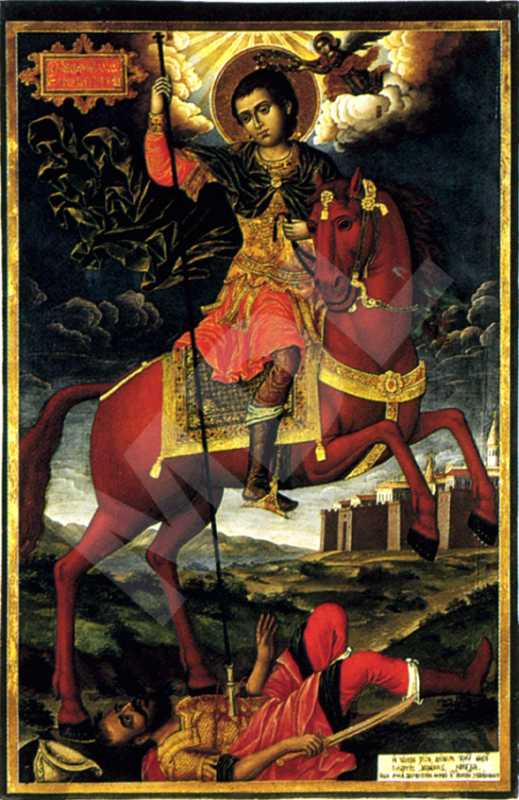St. Demetrius
Type:
Icon
Period:
1848 year
Dimiter T. Molerov, born in 1780 in Bansko, son of Toma Vishanov the Moler. One of the best-known painters, a representative of the Bansko school of art, a disciple of his father, influenced by the art of Athos. Author of the murals of the naos in the St Archangels' paraclete in the Rila monastery, the murals in the Church of the Assumption of the Virgin in the Pchelino dependance. In 1840 and 1841 together with his son Simeon Molerov he paints the murals and the sponsors' portraits in St. Nicholas' and St. John of Rila's paracletes in the principal church in the Rila monastery. Among D. Molerov's major achievements in iconography are the following icons: St. Nicholas (1816) from St. Archangel Michael's church in the village of Leshko, Christ All-triumphant with Angels and Cherubim (1833), The Nativity and a Crucifixion from St Elijah the Prophet's church in the village of Usenovo. He has also worked in Belgrade on an invitation by Prince Milosh Obrenovich of Serbia. He died in 1870 in Bansko.
Dimmensions (cm):
108
/ 73
/ 4
Location
Country: Bulgaria
Province: Blagoevgrad
Village: Teshevo
Church: St. Demetrius
Source
Country: Bulgaria
Province: Blagoevgrad
Village: Teshevo
Church: St. Demetrius
Description
The icon is painted after the traditional iconographic.The theme is treated in a vertical composition. Prevailing is the figure of Saint Dimiter, portrayed in full length, on horseback, at the moment when he is stabbing with his spear a brought-down warrior.
Iconographical technique: Egg-and-oil
With velaturas and gilding. The layer of painting is well preserved, at some places it is slightly rubbed away: on the horse's croup (without the saddle) and along the entire gilding, at some places even as deep as to the ground coat, on the brown velaturas and on on the velatura decoration on the gilding of the horse. The varnish cover is applied unevenly, in a thick layer; it is soiled and grown dark.
Base material: Wood
The base is made of two hand-made walnut panels, added to which is a narrow piece, attached with nails. Mounted in the upper and lower ends are two reinforcing softwood beams. The ground coat is laid in a thin layer and is in a good condition. There are along the joint between the two panels damages, some of which are filled up with wax.
State, restoration traces and comments
There are traces of retouchings on the saint's hair, made with a darker paint, which cover the original painting. The indicative inscription up above and the text down to the right had later on been overpainted. These overpaintings have subsequently been removed. Donor's inscription.


